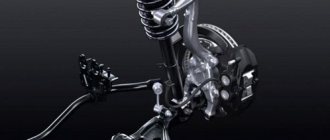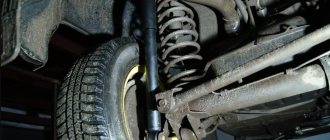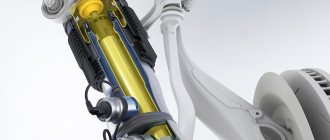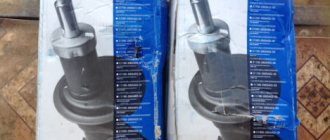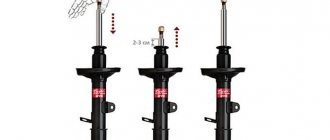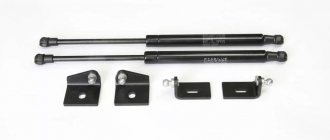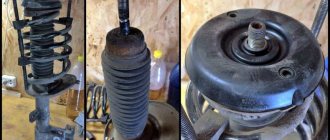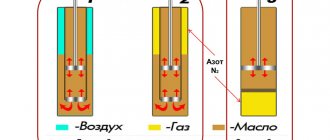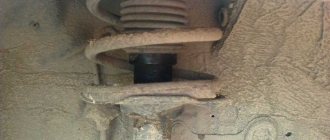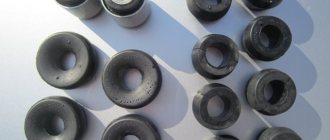The shock absorber is an important part of the suspension of any car. This device dampens vibrations and shocks resulting from driving on poor roads. Gas-oil shock absorbers are considered one of the best solutions - they are reliable, efficient and inexpensive.
Some brands of spare parts - for example DEQST deqst.ru - produce only such shock absorbers, calling them the best solution that ensures high comfort and vehicle controllability
But there is one caveat. They must be bled before installation.
Shock absorbers, what they are needed for and where they are installed
When accelerating, the vehicle “squats” backward, unloading the front wheels and loading the rear wheels, which reduces their grip on the road surface. When braking, the opposite is true. In both the first and second cases, the ideal position would be one in which the machine would maintain its normal “horizontal” position.
Approximately the same picture is observed during maneuvering, however, the load here shifts along the sides of the car, and not along the axes.
Shock absorbers keep the wheels in constant contact with the road surface to prevent the driver from losing control of the vehicle. The racks are installed directly next to the car wheels.
How to extend the life of car struts
To extend the service life of the racks, it is recommended to regularly treat the underbody of the car with anti-corrosion compounds. In the cold season, immediately after starting the car, you should not perform any sudden maneuvers or actions.
Sudden acceleration and braking with cold oil in the rack will significantly reduce the service life of parts. Well, one more tip - overcome serious obstacles at low speed.
Source
What is the difference between gas-oil products and oil products?
From the name itself it is already clear that their main difference is the working composition that is used inside the device.
In oil shock absorbers, the working space is filled with hydraulic oil.
The main disadvantage of these types of devices is aeration (oil foaming), which occurs as a result of changes in the physicochemical properties of the liquid when a piston acts on it in a small space.
This is manifested by a failure in the operation of the device and uncharacteristic sounds.
A partial reduction in aeration is achieved by replacing air with nitrogen gas; as a result, gas-oil analogues have appeared, which come in one or two pipes.
Single-pipe ones are often called gas ones, because there the oil and gas are separated by a movable jumper and do not mix.
IMPORTANT TO KNOW: Causes of shock absorber knocking. Strong backpressure ensures gas pressure in the region of 10 - 30 atmospheres; there are also adjustable analogues
Mainly installed on sports cars
Strong backpressure ensures gas pressure in the region of 10 - 30 atmospheres; there are also regulated analogues. Mainly installed on sports cars.
Twin-pipe gas-oil shock absorbers have less gas pressure - from 3 to 10 atmospheres.
But he won’t delve into the topic, because that’s not what you came here for. The shock absorber structure can be seen in the photo below.
Restoring gas pressure in the rack
- The shock absorber is firmly fixed in a vice, the position is vertical. It is necessary to thoroughly clean the part and blow out the entry point of the rod with compressed air. It is disassembled - the protective cap of the rod is removed.
For convenience, work is carried out in a vice
Use a pressure gauge to control. The method is suitable for gas and gas-oil racks
The process can be seen in the video.
Video on how to pump gas in a gas-oil rack
There are different opinions on how to fill a car shock absorber. Nitrogen, carbon dioxide or just compressed air? In a garage setting, there are few options. Compressed air will not significantly degrade the performance, especially considering that this is a repair and not a factory-made rack.
Bleeding the shock absorber: why is it done?
Let's start with the fact that today there are several types of shock absorbers, among which the most common and widely used are:
- oil shock absorbers;
- gas-oil shock absorbers;
- gas shock absorbers;
Without going into details, the differences lie in what one or another shock absorber is filled with. In short, oil struts are the softest and most comfortable, while gas struts are the stiffest, but hold the road better. In turn, gas-oil struts represent an average option in terms of rigidity and stability.
You can also note the design features, since the shock absorber can be single-pipe or double-pipe. At the same time, twin-tube shock absorbers are common today; they are installed on the vast majority of cars. For this reason, we will focus on pumping racks of this type.
So, as for the pumping itself, opinions on why it is needed differ somewhat. At the same time, shock absorber manufacturers themselves necessarily recommend bleeding before installing struts on a car!
As a rule, it is generally accepted that bleeding is necessary to remove the air gap from the mechanism. In other words, if there is air in the inner sleeve, the struts will not work normally when driving a car, and the piston shocks can damage the mechanism.
A sign of a problem is that the shock absorber begins to knock. In oil-filled shock absorbers, oil may remain in the inner sleeve, the strut will not function properly after installation and may leak quickly.
However, the widespread opinion about the presence of air in the shock absorber is questioned by many drivers and experts. In fact, to understand why pumping is needed, it is enough to study the information on the official websites of the manufacturers of the racks themselves. For example, below are the recommendations of KYB specialists.
- Bleeding twin-pipe shock absorbers before installation is a mandatory procedure! In double-pipe shock absorbers, the working fluid can flow from the inner to the outer cylinder during storage of the strut, and in parallel, boost gas enters the inner cylinder.
- An under-pumped shock absorber can cause failure of the entire shock absorber piston system, which is a violation of the installation instructions and will void the shock absorber warranty!
In other words, if the strut is not pumped, knocks and noises appear after installation, and the shock absorber valves are destroyed. For this reason, before installation on a car, pumping twin-pipe shock absorbers is necessary in order to bring the struts into working condition (prepare for work), as well as to check their functionality before installation on the car.
For example, during bleeding, you can identify a jammed valve mechanism, as well as other malfunctions. The pumping itself allows the oil and gas to be properly distributed inside the shock absorber.
As mentioned above, during storage and transportation the shock absorber lies, and does not stand as on a car, it can be turned upside down, etc. Of course, the contents of the rack are not distributed properly. In turn, bleeding allows you to eliminate undesirable effects on the valve mechanisms at the very beginning of the car’s movement after replacing the struts.
Why is pumping done?
Not everyone understands why pumping is done and whether it is necessary at all. Some clarity should be provided on this score in order to finally understand the meaning of pumping and the urgent need for such a procedure.
The working mechanisms of shock absorbers include special sleeves in their design. If air gets inside them, then the device will not be able to return to its original position. Moreover, before installation, air must be removed from new and old parts if you suddenly bought used shock absorbers because their price turned out to be lower. It cannot be ruled out that during the suspension repair process or during troubleshooting, air penetrated inside the mechanism.
During storage and transportation, the oil included in the shock absorber penetrates the outer cylinder of the structure, which is why the gas ends up inside the system. This phenomenon leads to the fact that after installing even a new part, a knock is heard.
By performing special actions, excess air is removed from the cylinder. This is done immediately before installation.
And it is still relevant to ask why this is being done. Everything is extremely simple. To ensure correct, efficient and long-term operation of new shock absorbers installed as part of a dependent or independent suspension.
Pumpable types of shock absorbers
Surely you know that shock absorbers are divided into oil, gas and gas-oil. All of them are quite actively used in the design of vehicles.
In this case, pumping is required for all categories of suspension units:
- front shock absorbers;
- rear;
- new parts;
- used;
- original;
- analog;
- single-pipe;
- two-pipe;
- collapsible;
- non-separable.
As you can see, it doesn’t matter what kind of shock absorbers we are talking about. All of them are subject to preliminary pumping before installation. Let you have at your disposal an ordinary old Gazelle or a brand new Audi. Although owners of expensive cars often prefer to have their car serviced at a car service center. But that’s not about that now.
Although it is not fundamentally important whether the shock absorbers are rear and new, or front and used, special attention should be paid to the specific type of element. Gas, oil and gas-oil shock absorbers have their own instructions. Relying on them, you can pump the part with your own hands, and the rack will work for a long time, efficiently and efficiently
Relying on them, you can pump the part with your own hands, and the rack will work for a long time, efficiently and effectively.
Gas shock absorbers
Let's start with pumping these particular shock absorbers. The gas most often used here is nitrogen. It's not difficult to upgrade them. You just need to follow a certain sequence of actions:
Replacing the Renault Logan timing belt: do it yourself or entrust it to a specialist
- Turn the assembly over so that the rod is pointing down toward the floor;
- Now slowly begin to compress the shock absorber;
- After squeezing, hold it in this position for a few seconds;
- Then turn the part the other way around;
- Hold the rod clamped for 4-5 seconds;
- Pull the rod back until it stops;
- Turn the shock absorber over;
- Leave the element in a horizontal position and install it on the car.
At this point, pumping is considered complete. Like I said, nothing complicated. Take your time, but also try not to keep gas-type shock absorbers in a compressed state for more than 6 seconds.
Oil shock absorbers
In the case of such car shock absorbers, the procedure is slightly different.
It is extremely important to strictly follow the given algorithm. The more accurately you follow the instructions, the higher the likelihood of doing everything as correctly as possible.
- Place the shock with the rod down, as in the case of gas elements;
- Smoothly compress the shock absorber until it stops;
- Having completed the compression, do not release the part and hold for 2-3 seconds;
- Without releasing the rod, turn the shock absorber over;
- Hold in a compressed state for up to 6 seconds;
- At this time, the air should come out;
- Then pull the rod out all the way;
- Turn the shock upside down;
- Wait about 3 seconds, and perform similar manipulations at least 3 times.
Although it is believed that the optimal number of such approaches for oil-based automobile shock absorbers is 6.
When you reach the third pumping, be sure to perform the so-called control action. It consists of the following:
- turn the shock absorber so that the rod points upward;
- make several short but sharp compressions of the rod.
In this case, the movement of a properly pumped shock absorber must be as smooth as possible, without dips or jerks. If this occurs, you need to repeat the pumping procedure.
We pump original oil shock absorbers of Lada Priora
These bleeding methods are suitable for most shock absorber struts installed on domestic cars, including the VAZ 2107.
Doing the work manually is not easy, but it is possible. Please note that the front shock absorbers on the Priora are not replaceable and those from other models, especially the VAZ 2110, are not suitable, they have different springs.
There are two methods of pumping, without turning over and with turning over the shock absorber strut.
But there are general recommendations that must be followed in all cases.
- When pumping, the shock absorber should be in a vertical position, and if tilted, then no more than a few seconds;
- Bleeding must be carried out immediately before installation on the car;
- Do not use a tool that can damage the product (gas wrench, hammer, pliers), hydraulics is a delicate matter, remember this;
- Do not allow the rod to rotate in the stand itself around its axis;
- Apply efforts smoothly, without jerking;
- An already pumped shock absorber must be in a vertical position at all times.
Method 1
Place the shock absorber strut on a level place with the lug facing down.
The task is to fully extend the rod when pumping at least 10 times and return it back, thereby ensuring that the liquid (oil) evenly fills the working space.
It is difficult to pull the rod out by hand, so they come up with different devices.
In our case, you can take a 30mm adjustable wrench with a hole in the handle whose diameter just allows you to use the tool as a lever.
Place the key on the rod so that the threads do not touch and take it to the break.
Do not sharply, using even force, pull it out until it stops.
We return it back smoothly, without any jerks.
The latter should go down easier than up, the ideal case is when the lowering occurs under its own weight. But if the rod does not fall without influence on it, this is not scary.
We repeat the steps cyclically at least 10 times, pay attention to possible jerks when retracting and pulling the stand, extraneous sounds and gurgling.
Their presence is allowed at the beginning and middle of the procedure, but at the end of pumping they should not be present. If necessary, increase cycles to 15–20 times.
The rear suspension struts on Priora are interchangeable; the rear strut from VAZ 2110, 2111, 2112, Lada Samara, Granta, Kalina will fit here.
Using the same wrench to 30 we pump up the rear shock absorber.
Please note that the rear strut does not come with a nut, which increases the likelihood of thread damage.
Temporarily screw in any nut or bleed with extreme caution.
Insert a rod (or a large screwdriver) into the hole at the bottom to hold the stand with your feet.
After pumping, the shock absorbers can be installed in the garage with your own hands, but since this is quite labor-intensive work, many people prefer to do it at a service station.
To prevent the devices from turning over to a horizontal position, they can be placed in factory boxes, twisting the latter with tape.
Method 2
The oil shock absorber is pumped according to the following algorithm:
- The rack rod must be positioned so that it is extended to 75% of its length;
- Turn the shock absorber over with the rod down and rest the latter on the floor;
- Applying even force, press the rod until 4-6 cm remains to the rack body. Wait 5-6 seconds.
- Turn the device over, wait 5-6 seconds again, and pull the rod out to 75% of its length. Break – 2-3 seconds.
- Press the rod in again.
Carry out the operation 6 to 10 times, and on the third and sixth repetitions, try to move the rod with sudden efforts, which in any case should move smoothly. If not, the procedure continues.
Operating principle
It doesn't matter how the shock absorber is designed. All of them, regardless of type, operate on the same principle
This means that, regardless of type, they need pumping. In the shock absorber chamber, the piston performs a reciprocating movement. The piston has several holes. As the mechanism moves, the pressure in the chamber increases. By the way, it becomes larger when the car moves at low speed.
The most common faults
Among the most popular malfunctions are:
- Fluid leaks;
- Deformations and mechanical damage to the housing;
- Damage to the rod or piston;
- The oil is inappropriate or of poor quality.
Leaks can occur due to wear of oil seals or other seals. Oil seals also wear out naturally - the rod is constantly moving, so the edge of the oil seal wears out after some time. However, most often the oil seal gets damaged due to corrosion, scuffing and dust, sand on the rod.
Deformation of the housing is usually caused by impacts on the housing of the damping device. Dents do not allow the rod to move normally to its full height and in the place where there is deformation, the piston can rest.
The piston can be damaged only in one case - if the car falls into a hole at speed. The damper cannot withstand it and breaks through. At the moment of breakdown, the piston collides with the bottom of the chamber, which causes damage to the piston. As a result, the valves are also damaged, and the processes of oil flow from chamber to chamber are seriously disrupted.
Oil is the working fluid in a car shock absorber. The operation of the damper depends entirely on its characteristics and quality. If the oil has a low viscosity, then there will not be the required resistance to the movement of the piston - the damper will “break through” even on small bumps. In winter, oil with a higher viscosity will create too much resistance.
How to properly check shock absorbers on and off the road
You can determine whether the damper is working properly by its appearance. If traces of oil are visible on the body, this indicates a violation of the tightness of the chambers due to wear of the oil seals or seals. The properties of such a damper will be below normal or will not exist at all.
The body is also inspected for deformations - even a slight dent can lead to difficulty moving the piston and to complete jamming.
Fasteners must be intact and not damaged by corrosion. The rubber bushings installed in the lower hinge must also be intact and have no signs of destruction.
The damper rod must have a perfect mirror surface. If there is no mirror, then the piston has no movement and the shock absorber does not perform its function.
If the shock absorber has already been removed, then to check it, install it vertically. The bottom bracket is fixed with your feet, and the rod is pulled out with your hands and released. If the shock absorber is working properly, then the resistance to the upward movement of the rod should be much greater than the resistance when the rod moves down.
If the rod moves both down and up with the same force, then there is little or no oil in the cylinders. If the resistance decreases in the extreme positions of the rod, then this indicates air in the chamber cylinder.
You can check the operation of the shock absorbers on the car. To do this, swing the car by the front and then by the back. If the damper is working properly, the car will swing once. If the rack is jammed, you won't be able to rock the car.
Bleeding rear shock absorbers before installation
Bleeding is an easy procedure; new shock absorbers do not need to be sent to a service center. To properly pump the device, you need to follow this sequence of actions.
- Install the stand with the stem down. The base must be solid, ideally a concrete floor.
- Smoothly compress the product.
- We fix the position for two seconds.
- To get the rod back, you need to turn the shock absorber over and pull the tube out manually. Usually the rod rises without outside help.
- Leave the rod in the extended position.
- We repeat the procedure two or three more times.
After this, the rear struts can be installed on the lever or axle of the car.
Repair or replacement? What you can do with your own hands
In fact, this is not such a simple task. Before carrying out work, you should carefully study the material and follow safety precautions. First of all, you need to determine whether your shock absorber is collapsible or not. The monolithic body cannot be repaired; opening it with a grinder and welding it is unacceptable.
If there is a nut or retaining ring where the rod enters the pipe, such a shock absorber strut can be serviced and repaired.
This is what a repairable rack looks like
How to work with gas oil
Help: The spelling “gas-oil” is erroneous. That’s right: “gas-oil.”
Gas-oil shock absorbers must also be pumped before installation, whether new or used.
- The stand must be turned into a vertical position with the cylinder facing up.
- It is necessary to compress the shock absorber and hold it in this position for several seconds. Hold the shock absorber in the lowered position for several seconds
- Next, the shock absorber turns over, but must be in a compressed position.
- The cylinder is pulled out very slowly to its original position. Smoothly pull the cylinder up
- The procedure should be performed 3-4 times at short time intervals - no more than a few seconds.
After bleeding, do not turn the shock absorber over, otherwise you will need to perform the procedure again. If you hear a slight slurping sound when you press the body, don’t worry. This is not a malfunction.
How to pump such shock absorbers (video)
https://youtube.com/watch?v=-9JfmTW1ldM
If all actions are performed correctly, there should be no knocks or other extraneous sounds. Otherwise, the procedure should be repeated. If you cannot bleed the shock absorber yourself, you should contact a specialized service. There are many devices, stands, attachments and other special equipment for high-quality performance of the procedure.
How are gases pumped?
The algorithm for working with shock absorbers filled with special gas is as follows:
- The part is turned over with the rod towards the ground.
- After this, you need to smoothly compress and fix it for several seconds.
- After completing the procedure, you need to turn the part over; you must hold it there for no more than 6 seconds.
- The next stage is to extend the rod all the way;
- The final stage is turning the shock absorber over.
Instructions for installing oil and gas-filled shock absorbers
To ensure that your shock absorbers last as long as possible, we recommend following the rules below:
1. Immediately before installing the shock absorber, it must be pumped as follows:
- turn the shock absorber upside down and wait 3 - 5 seconds;
- Slowly compress the shock absorber all the way and wait 3-5 seconds;
- holding the shock absorber in a compressed state, turn it over to the working position and wait 3-5 seconds;
- after this, let the rod come out (for gas-filled shock absorbers); for oil shock absorbers, it must be pulled out for the entire working stroke
- procedure 1-4 should be repeated several times until the failure completely disappears when the shock absorber is operating on rebound (point 4).
2. It is necessary to use a special tool to hold the rod from turning to prevent damage to the chrome plating.
To do this, it is prohibited to use pliers, a gas wrench or other tools not intended for these purposes, because worn chrome plating of the rod can lead to disruption of the shock absorber's operating functions.
Soon this defect will lead to wear of the oil seal and rod guide. This, in turn, leads to oil leakage and reduced shock absorber service life.
3. Shock absorbers should only be tightened after the vehicle is on its wheels, or when the wheels are raised with a transmission jack or similar equipment to level the shock absorber mounting locations.
4. It is unacceptable to use pneumatic tools to install shock absorbers. Using such tools may result in the threaded part of the shock absorber rod breaking off.
5. It is necessary to use a torque wrench (wrench with a torque limiter) when tightening threaded connections to maintain the tightening torque; overtightening the nuts and bolts can damage the fasteners and can cause premature failure of the shock absorber.
When operating a car in the winter, after a long period of parking, it is necessary to drive the first 500 meters at a speed of no more than 30 km/h to warm up the oil in the shock absorbers to operating temperature.
based on materials from the site: https://www.4x4sport.ru/publications.html?publications=publications20
» data-medium-file=»https://i2.wp.com/avtoivan.ru/wp-content/uploads/2018/09/dinamometricheskij-klyuch.jpg?fit=300%2C168″ data-large-file= »https://i2.wp.com/avtoivan.ru/wp-content/uploads/2018/09/dinamometricheskij-klyuch.jpg?fit=960%2C539″ data-lazy-src=»https://i2. wp.com/avtoivan.ru/wp-content/uploads/2018/09/dinamometricheskij-klyuch.jpg?fit=960%2C539″ data-lazy-srcset=”https://i2.wp.com/avtoivan.ru /wp-content/uploads/2018/09/dinamometricheskij-klyuch.jpg?w=960 960w, https://i2.wp.com/avtoivan.ru/wp-content/uploads/2018/09/dinamometricheskij-klyuch. jpg?resize=300%2C168 300w, https://i2.wp.com/avtoivan.ru/wp-content/uploads/2018/09/dinamometricheskij-klyuch.jpg?resize=768%2C431 768w" data-lazy- sizes=”(max-width: 960px) 100vw, 960px” />
When the front and rear shock absorber struts need to be checked
Typical malfunctions of this unit are known to everyone:
- Depressurization of the rod seal. Leads to oil leakage from the strut. It can leak at any time. Characteristics change until complete loss of performance.
- The rod moves too freely in the pipe. In fact, the shock absorber strut turns into a guide for the suspension spring. The malfunction is related to the internal valves.
- Play during compression or rebound. Associated with production in the rod or cylinder. The consequences are similar to broken valves. The shock absorber does not perform its function in the car, it knocks, rattles and makes other unpleasant sounds, which is why driving in such a car becomes uncomfortable and dangerous.
- External damage - dents on the body, cracks in the eyelet. They affect the chassis as a whole and can lead to more serious damage.
If any malfunction is detected, it is necessary to remove the strut and free it from the spring. Dismantling is carried out in the garage, without the use of special tools.
Sometimes owners of foreign cars, noticing that their struts have leaked, turn to a service station for diagnostics, where they will test them on a stand.
The design and principle of operation of a car shock absorber
So, what is a shock absorber and what is it for? When driving over bumps, different forces act on the wheels of the car. These forces are transmitted to the car body using springs and a system of suspension arms. A significant part of the forces is absorbed by springs and suspension arms. But every action has a reaction.
For example, a car wheel ran over a bump, the spring compressed (that is, it took the impact and accumulated energy) and you felt almost nothing. But the spring is already compressed and it must deflate, and having done this, it will give off part of the accumulated energy to the car body, simply throwing it up.
Having thrown the body up, the spring is without load and pulls the wheel upward, trying to tear it off the road. This will happen exactly until the moment the car body again begins to put pressure on the spring and, accordingly, on the wheel. At this moment, the wheel practically does not touch the road, and you risk losing control.
The body, having pressed on the spring and pressed the wheel to the road, again compressed the spring, which had accumulated energy, and which in a split second would certainly begin to decompress, and the whole cycle would begin again. And this will continue until the vibrations die out. But as soon as the vibrations die out, another bump in the road will definitely appear and everything will begin with renewed vigor.
In order to prevent rocking of the car body, as well as to prevent the transfer of compression energy from the spring to the car body, shock absorbers are used. These devices do not allow spring vibrations to occur during decompression, and if they do occur, they are quickly damped.
In this article I will not go into ancient times (by automotive standards) and talk about friction-type shock absorbers. I’ll start my story with shock absorbers that are widespread everywhere - these are hydraulic shock absorbers.
Today, two types of hydraulic shock absorbers are used in cars - single-tube and double-tube. Or as they are also popularly called oil, gas-oil and gas. Which is not entirely true, because at the moment there are practically no oil shock absorbers left on the market. The vast majority of modern shock absorbers are gas-oil. And they differ in design - single-pipe and double-pipe. Gas shock absorbers are used under increased loads, for example in motorsports, and are several times more expensive than gas-oil shock absorbers.
So, next we will talk about gas-oil shock absorbers, which we will divide into single-pipe and double-pipe.
One- and two-pipe mechanism
Before we tell you how to bleed shock absorber struts, you need to find out the difference between the types of struts. Two-pipe solutions are considered the simplest and most widespread. Gas or oil is used as a working substance. The main disadvantage of these models is considered to be poor cooling. The oil gets very hot due to the small volume of the chamber. High temperatures lead to foaming. This prevents the rack from working properly. Therefore, you need to know how to bleed the front and rear struts.
Gas-oil struts are partially protected from foaming. Air and oil are pumped into the housing from two pipes. The first one is pumped under low pressure. Sometimes nitrogen is used as a gas. This solution reduces the risk of foaming.
Tips for replacing shock absorbers
However, shock absorber manufacturers offer a number of tips to help you replace them correctly and quickly. For example, the manufacturers of KYB and Kayaba recommend adhering to the following recommendations:
- When bleeding the shock absorber, do not use any additional tools to hold the rod in order to avoid damage to the seal and possible premature leakage of fluid;
- do not use pneumatic tools to tighten the rod nut;
- It is highly undesirable to use old boots when replacing the original shock absorber,
- gaskets and shape washers;
- shock absorbers should only be installed in pairs;
- Before fixing the upper mounts, you must make sure that the car rests freely on four wheels and all jacks and stands have been removed.
Thus, it is necessary to prepare the shock absorber for use when replacing it, and if you take into account the manufacturer’s recommendations, the unit will last a long time and without problems. Smooth roads to all!
Useful tips
Having looked at how to bleed a shock absorber, we can conclude that the main task is to redistribute the working fluid or filler inside the strut, as well as check the performance of the shock absorber itself before installing it directly on the car. Ignoring this rule can lead to knocking and noise while driving, failure of the struts themselves, as well as problems with the warranty on shock absorbers.
We also note that if a mono-tube shock absorber is installed, this type does not particularly need pumping (usually filled with gas under pressure, and the chamber is separated from the rest of the strut by a sealed piston). This means that oil does not enter the gas chamber.
We also recommend reading the article about what symptoms of a torn engine mount indicate that the engine mount is faulty or damaged. From this article you will learn about the main signs by which you can determine that there are problems with the engine mount, as well as the available methods for diagnosing this malfunction.
However, pumping such a shock absorber is also recommended in order to be able to identify possible shock absorber defects or problems in advance, that is, before installation on the car. To pump up a monotube shock absorber, some car enthusiasts recommend placing the strut with the rod up, then smoothly pressing the rod down (2-3 cm before reaching the end of the stroke).
Then you need to turn the stand over with the rod down, hold it for about 5 seconds, extend the rod, and lift the shock absorber with the rod up. Next, you can check the quality of its work.
How to bleed racks before installation - step-by-step instructions
Today there are the following types of shock absorbers:
- gas (most often using nitrogen);
- oil;
- gas-oil.
The process of performing a procedure of this type for each variety is associated with some significant features. Familiarization with them is mandatory. If mistakes are made, the working part will quickly fail during intensive use of the car, which threatens early repairs.
Before we get started, I advise you to read our recent article, which discussed the front shock absorber struts. I'll leave the link here. Go ahead, read, get new useful information.
Pumping is considered a key condition for proper installation and further effective operation of the unit. If you do not do this, the part will fail. Moreover, such a malfunction does not fall under the terms of the warranty case. Everything will have to be corrected at your own expense.
The condition of roads in the post-Soviet space is far from the best. This is confirmed by the need to regularly replace shock absorbers on cars. If the operation is carried out at a service station, then there are no problems with this. For those who decide to carry out repairs themselves, you need to know how to perform this operation correctly.
Varieties If a car enthusiast knows what shock absorbers he knows, then we will get something like this: oil, gas-oil and gas. This answer is partially correct. It is more correct to divide into two types: oil and gas. This division is based on the use of different working substances.
Gas shock absorbers use an inert gas, most often nitrogen, pumped under high pressure. In oil shock absorber struts, hydraulic oil and air or gas are pumped into the working space. Structurally, they are divided into two types: two-pipe and single-pipe. The first type of shock-absorbing struts is the most common due to its simplicity and low cost of manufacture.
Oil or gas and oil are used as the working substance. The main disadvantage of oil shock absorbers is poor cooling of the working substance. The oil gets very hot due to its small working volume. High temperatures cause the oil to foam and the shock absorber stops working correctly.
Wait 3–5 seconds. 3. Turn the shock absorber over. Wait 3-5 seconds.4. Extend the rod smoothly to 3/4 of the length. Wait a couple of seconds.5. Turn the shock absorber over and press the rod in again.6. Repeat steps 2–5 from three to six times. After the third swing, check. In this case, you need to sharply press the rod several times - it should move smoothly without jerking.
How to check a shock absorber
If you are going to install a dismountable oil shock absorber, first open it and check the condition of the parts and the oil level. If necessary, add spindle oil or automatic transmission and power steering fluid with a low freezing point. You may be able to find “shock absorber fluid” like AZh-12T or something similar in a car store. When the rod is fully inserted, the oil level reaches the upper locking nut. Remove the cylinder. If you do not have a cylinder, but a cartridge, then adding oil or visually assessing the condition of the parts will not be possible.
Inspect the piston and valve; there should be no distortions anywhere. If you find torn rubber parts or burst springs, replace them. Check the oil - there should be no dirt, pieces of rubber or metal, bubbles or a burning smell. If the oil is dirty, drain it and wash the body with diesel fuel. After making sure that everything is normal, insert the cylinder into the shock absorber body and fill/add oil, then tighten the fixing nut.
Varieties
If a car enthusiast knows what shock absorbers he knows, then we will get something like this: oil, gas-oil and gas. This answer is partially correct. It is more correct to divide into two types: oil and gas.
This division is based on the use of different working substances. Gas shock absorbers use an inert gas, most often nitrogen, pumped under high pressure. In oil shock absorber struts, hydraulic oil and air or gas are pumped into the working space.
Structurally, they are divided into two types: two-pipe and single-pipe.
The first type of shock-absorbing struts is the most common due to its simplicity and low cost of manufacture. Oil or gas and oil are used as the working substance. The main disadvantage of oil shock absorbers is poor cooling of the working substance. The oil gets very hot due to its small working volume. High temperatures cause the oil to foam and the shock absorber stops working correctly.
Shock absorbers are structurally made into two-pipe and single-pipe. Oil and gas are pumped into the middle
Gas-oil shock absorber struts are partially free of this drawback. Oil and air are pumped into a two-pipe housing under a pressure of 2–3 atmospheres. Sometimes nitrogen is used instead of air. This solution reduces the likelihood of aeration - foaming of the oil.
This is interesting: Apple has taught iOS 7 to connect to machines
Structurally, monotube shock absorbers do not have a working chamber. It is replaced by the rack housing. The tube is divided into two sections. The upper part is filled with oil, and the lower part is filled with high pressure gas. There is a valve between the sections.
Gas shock absorbers are of particular interest to drivers. This is no accident. Gas struts are primarily used in motorsports. For sports driving, this type of rack is most often chosen. The operation of the gas shock absorber is ensured by pumped gas under high pressure. Such racks are the toughest and driving on city roads is accompanied by shocks and impacts. Such a ride cannot be called comfortable, but driving will be clear and controlled. Therefore, gas shock absorber struts are used mainly on racing cars.
A special type of shock absorbers are the so-called “reversals”. They were given this name not because they can be placed upside down. In such racks, the reverse position of the rod is used. In conventional shock absorbers, the rod is directed upward. In inversions, the rod is directed downwards and is attached to the shock-absorbing strut body. There is a pseudo-rod on top. It looks much thicker. The operation of the inverted shock absorber is ensured by several plain bearings. This design reduces the vertical and lateral load on the rack.
Required Tools
- A compressor for supplying compressed air or a pump for servicing bicycle shock absorbers.
- Special fitting for injection of compressed air.
Attention! It is necessary to take care of safety. The work involves high pressure, so eye and hand protection is required.
